APS Journals at Convention
Leading Researchers Discuss Current Directions in Schizophrenia
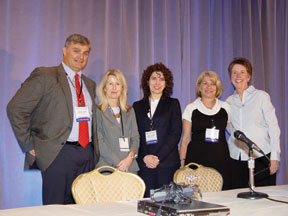
Symposium speakers Tyrone Cannon, Jill M. Hooley, Robin Cautin, Elaine F. Walker, and Ann M. Kring
In a special pre-convention event, five distinguished researchers came together to discuss the latest research on schizophrenia, a debilitating mental disorder that affects millions of people worldwide. Though each of the researchers examined a different facet of the disease, all five, all five, whose articles were among those in a special issue of Current Directions in Psychological Science last year. agreed that schizophrenia research has come a long way.
According to Robin Cautin, a psychological scientist from Manhattanville College who provided a brief history of schizophrenia research, most of the research conducted in the early 20th century was based on trial and error.
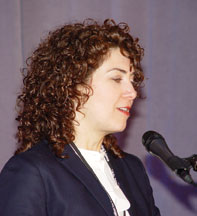
Robin Cautin
Cautin discussed the work of psychologist David Shakow, who revolutionized clinical research of schizophrenia. It was Shakow who introduced a rating system for classifying patients and created strict standards for clinical studies. He was also known for implementing an interdisciplinary approach. “Shakow recognized that the complexity of the condition required a complex approach,” said Cautin.
The influence of Shakow’s work was evident in the presentations that followed. Tyrone Cannon, University of California at Los Angeles, presented preliminary results from a neuroimaging study in which he and his team investigated synaptic pruning in the prefrontal cortex, a process in which the number of connections between brain cells decreases during adolescence. “People who convert to psychosis have a distinct pattern,” said Cannon. “It seems to reflect an underlying exaggeration of the pruning that occurs during normal adolescent development.”
In other words, individuals who are at risk for schizophrenia have fewer connections between their prefrontal cortex neurons than do normal adolescents. So when synaptic pruning occurs and even more synapses are removed, the at-risk individuals may be losing too many connections, which could lead to psychosis.
Ann Kring University of California at Berkeley, discussed the role of emotion in schizophrenia. According to Kring, many schizophrenia sufferers experience emotions, but they display fewer outward signs of emotion than unafflicted individuals. Sufferers also have deficits in the ability to anticipate and remember pleasure. In an fMRI study, Kring’s team found that schizophrenia patients and control subjects had similar brain activity “in the moment” when they were shown pleasing pictures. But schizophrenia patients showed less activation after the picture was gone, which indicates that they are not “savoring” the memory as much as the healthy control subjects.
Jill Hooley, a clinical psychologist from Harvard University, talked about the social factors of schizophrenia. “The majority of patients with this disorder do not marry,” she says, and the lack of marriage reflects the difficulty that many schizophrenia patients have with social relationships. Hooley mentioned some studies demonstrating that social-skills training can improve patients’ social functioning and reduce their rate of relapse, but she said researchers must remain “cautiously” optimistic about these results.
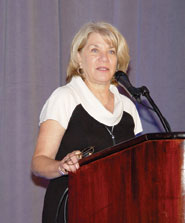
Psychological Science in the Public Interest (PSPI) editor Elaine Walker
The symposium ended with a presentation by Symposium Chair Elaine Walker, an investigator from Emory University who discussed the role of hormonal changes in schizophrenia. Research by her lab found that individuals who developed schizophrenia showed a large increase in secretion of the hormone cortisol the year before their psychotic symptoms emerged. In a separate study, Walker and her team found that people at risk for schizophrenia were more sensitive to stress than people in a control group. Walker said that these findings suggest that stress and the accompanying hormones may lead to exacerbation of schizophrenia symptoms.
At the end of her talk, Walker called for a continuation of the interdisciplinary approach started by Shakow in the early 1930s. “What I think this symposium has demonstrated clearly is that we are using multiple methods. Research on psychopathology is a multidisciplinary endeavor,” said Walker. “We need people who know about behavior, who know about the brain, who know about interactions between neurotransmitters and neurohormones. And we need to try to put this all together in a way that will help us answer this puzzle.”
– Meagen Voss
Perspectives on Science Writing
Speakers in the “Perspectives on Science Writing” workshop at the APS 23rd Annual Convention had a clear, basic message: just write. Write a lot, whenever you can. Set yourself a goal, don’t make excuses, and minimize distractions. Close your Internet browser, for example, and stop reading blogs when you should be working on your thesis!
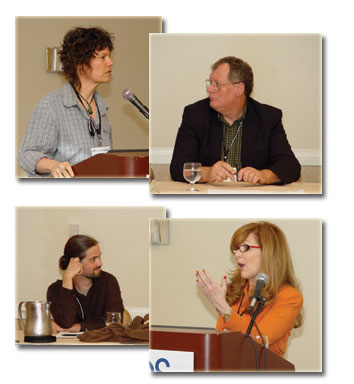
Top to bottom: Maryanne-Gary, Randall W. Engle, Paul Silvia, and Morton Ann Gernsbacher
APS journals were well represented in the workshop. Editor of Current Directions in Psychological Science Randall Engle and Editorial Board Member of Psychological Science in the Public Interest Morton Ann Gernsbacher spoke along with Maryanne Garry, of Victoria University of Wellington, New Zealand, and Paul Silvia of the University of North Carolina at Greensboro.
Each speaker offered unique perspective based on years of writing experience, but all agreed that you should keep things simple. There’s no need to overcomplicate your writing. Don’t pull out a thesaurus to find arcane words and convoluted phrases to express straightforward concepts. As Garry said, write as if your grandmother were your ideal reader.
Another key focus was the structure of the article. The panel agreed that it’s best to open with a hook: Give the reader some interesting example of behavior that they can relate to or a story that leads into the primary research question. However, don’t ramble about the things you did before you came up with the research you’re really reporting. Focus on the essentials. As Engle observed, the goal should not be just to get published, but to interest people in reading your work. Writing is a skill that can be learned, but like everything valuable in life, doing it well requires constant use and practice.
– Brian Winters
PSPI Symposium Highlights Bilingualism and Giftedness
Ellen Bialystok, lead author of a recent issue of PSPI, Bilingual Minds was the first to speaker at this year’s Psychological Science in the Public Interest (PSPI) Symposium. The question posed was, “is there a way to find relationships between bilingualism and the mind and brain?” The answer is an unequivocal “yes.” Bialystok discussed numerous studies that have pointed to how bilingualism affects and ultimately improves cognition.
As Bialystok explained, all varieties of studies have shown that “if you’re bilingual, when you’re using one of your languages, the other one is active and available, even if there’s no conceivable reason you’re going to need it.” This produces conflict and competition between the two languages, which is manifested in the fact that bilingual individuals, relative to monolingual individuals, take longer to retrieve individual words, make more errors, and have more tip-of-the-tongue experiences.
All of those seem undesirable, and for decades it was indeed thought that bilingualism was actually a cognitive hindrance. But a huge body of research has since shown that these disadvantages pale in comparison to the advantages conferred by the greater cognitive effort expended by bilingual individuals. Because linguistic processes are more effortful for bilinguals, they need to recruit the brain’s executive control system to manage the conflict between the two activated languages in a way that monolinguals do not. This effortful management of two languages actually modifies the brain systems involved in other executive control capabilities, which enhances the ability to resolve conflict in areas other than language.
Even more intriguingly, there is evidence that this bilingual advantage extends to cognitive reserve. Studies have shown that bilingual individuals who develop dementia show first symptoms 5 years later, on average, than their monolingual counterparts, probably because this enhanced cognitive reserve increases the ability of bilinguals to compensate for the disease.
Lead author of a forthcoming PSPI report on gifted education, Rena Subotnik spoke next saying that many have questioned the degree to which giftedness is a matter of “innate” ability, effort, or opportunity. Ability certainly plays a role, Subotnik said, but it is really a combination of genes and environment. And effort and opportunity are just as crucial. Certainly, schools, mentors, coaches, and others can have an influence on whether particularly talented young people excel in their chosen domain and perhaps achieve eminence as an adult.
Previous studies, most famously the longitudinal study conducted by Lewis Terman, have shown only limited connection between childhood talent and adult eminence in academic domains. Subotnik explained that their report is considering a range of domains — not only domains like academic fields in which excellence is manifested in the production of something, but also domains such as music and sports, wherein achievement is a matter of performance. For a variety of reasons, there are less opportunities to nurture production than performance: There is a lack of consistent funding at state and federal levels for gifted education, and gifted programs, when they do exist, “stop at the doors of college.” They are meant to help academically talented kids get into good colleges and universities, but there is little further support for their talents.
Athletics and musical performance are a stark contrast. Those who show extreme talent in those domains are often invested in heavily in college and beyond. Subotnik related that a former manager of the Dallas Cowboys once told her that his team was the “ultimate gifted program” — millions being spent in selection, training, and maintenance of the highest-caliber athletes.
There are a number of reasons for the disparity. For one thing, performance is better understood and appreciated by ordinary people: “Average people can appreciate a dance performance much more easily than a discussion of string theory.” In academic domains, excellence is appreciated mainly by those within that domain.
Another reason is that achievement in sports and music depends on physical skills with benchmarks that can be measured and assessed easily and with a high level of consensus, whereas standards for measuring academic talent and achievement are more nebulous. Subotnik noted that applicants to Juilliard undergo a 10-minute audition in which judges are generally in agreement about acceptance versus failure, and parents do not generally challenge the judgment. “Nobody sues Juilliard if their kid doesn’t pass the audition,” she said. In contrast, parents often do not have confidence in the ability of schoolteachers to judge their children’s academic talent or creativity.
Despite growing concerns that the United States is falling behind other countries in science and engineering fields, U.S. culture perceives academic achievement as elitist — which contributes the widespread resistance to greater funding for gifted programs. This devaluation is clear even at the level of school culture: Talented athletes are revered, whereas academically gifted kids are often branded with derogatory labels like “nerd” and “brainiac.”
If we accept that opportunity influences talent, Subotnik said, then children need to be supported across all domains, with continual opportunities not only for nurturance of talents but also for strengthening of psychosocial skills necessary to achieve and compete. These include skills to negotiate both the opportunities and the obstacles talented people will encounter: handling setbacks, adjusting anxiety levels for optimal performance, imagining success, as well as basic social skills. “Olympic winners are supposed to be able to deal with adversity, come back from failure, and imagine winning,” she said. Academically talented individuals are only taught such skills haphazardly, if at all.
Transformation of talent into achievement and ultimately (one hopes) eminence also depends on effort and the will of the talented individual to achieve. Even where opportunities exist, Subotnik said, talented young people do not necessarily receive encouragement to pursue their area of special talent.
– Eric Wargo


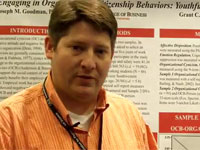
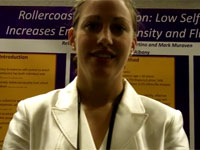

APS regularly opens certain online articles for discussion on our website. Effective February 2021, you must be a logged-in APS member to post comments. By posting a comment, you agree to our Community Guidelines and the display of your profile information, including your name and affiliation. Any opinions, findings, conclusions, or recommendations present in article comments are those of the writers and do not necessarily reflect the views of APS or the article’s author. For more information, please see our Community Guidelines.
Please login with your APS account to comment.